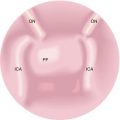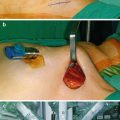(1)
Department of Endocrinology, Imperial Centre for Endocrinology, Hammersmith Hospital Campus, Du Cane Road, London, W12 0HS, UK
Abstract
PNETs arise from neuroendocrine cells within the pancreas. Most (up to 90 % in some series) do not secrete hormones (nonfunctioning) and may be an incidental finding on imaging. The rest are described as functioning. These exhibit hypersecretion of various hormones and are generally defined by their secretory products. They may produce one or more hormones, which subsequently give rise to a specific clinical picture (Table 8.1).
Definition of Pancreatic Neuroendocrine Tumors (pNETs) and Subdivisions
PNETs arise from neuroendocrine cells within the pancreas. Most (up to 90 % in some series) do not secrete hormones (nonfunctioning) and may be an incidental finding on imaging. The rest are described as functioning. These exhibit hypersecretion of various hormones and are generally defined by their secretory products. They may produce one or more hormones, which subsequently give rise to a specific clinical picture (Table 8.1).
Table 8.1
Clinical features associated with different types of pancreatic NET
Tumor Type | Symptoms |
|---|---|
Insulinoma | Hypoglycemic episodes |
Sweating, tremulousness, tachycardia, hunger | |
Neuroglycopenic symptoms | |
Headache, lethargy, diplopia | |
Seizures, loss of consciousness | |
Weight gain | |
Gastrinoma | Zollinger-Ellison syndrome |
Abdominal pain from multiple gastroduodenal ulcers | |
Upper GI bleed or perforation | |
Heartburn or acid reflux | |
Diarrhea | |
Nausea and vomiting | |
Weight loss | |
Symptoms may respond to high-dose PPI | |
VIPoma | Profound watery secretory diarrhea |
Electrolyte disturbance (hypokalemia) | |
Lethargy | |
Nausea and vomiting | |
Abdominal pain | |
Glucagonoma | Hyperglucagonemia, hyperglycemia |
Weight loss | |
Diarrhea | |
Stomatitis | |
Necrolytic migratory erythema | |
Erythematous blistering rash seen over lower abdomen, perineum, and groin | |
Deep vein thrombosis | |
Somatostatinoma | Diabetes/impaired glucose tolerance |
Gallstones/gallbladder disease | |
Diarrhea/steatorrhea | |
Weight loss | |
Abdominal pain | |
Nonfunctioning | No hormonal hypersecretion |
Late presentation therefore often metastatic | |
Nonspecific abdominal symptoms often due to tumor mass or local invasion | |
Abdominal pain | |
Weight loss, anorexia, nausea | |
Jaundice |
Epidemiology and Pathology
PNETs are rare, occurring with an incidence of less than 1:100,000. However, postmortem findings suggest that these tumors are more common than previously thought, up to 10 % in some studies. Many small tumors that are nonfunctioning, and therefore asymptomatic, remain undiagnosed. Patients with functioning tumors are more likely to be symptomatic and so tend to be diagnosed at a younger age. Overall survival is better in those with functional lesions although it is important to bear in mind that lesions found incidentally on screening may otherwise have been one of those that patients would otherwise have never known about. Aggressive treatment of such lesions may suggest that whatever treatment is used is effective, leading to publication bias in favor of surgical or other treatment.
Stay updated, free articles. Join our Telegram channel

Full access? Get Clinical Tree





